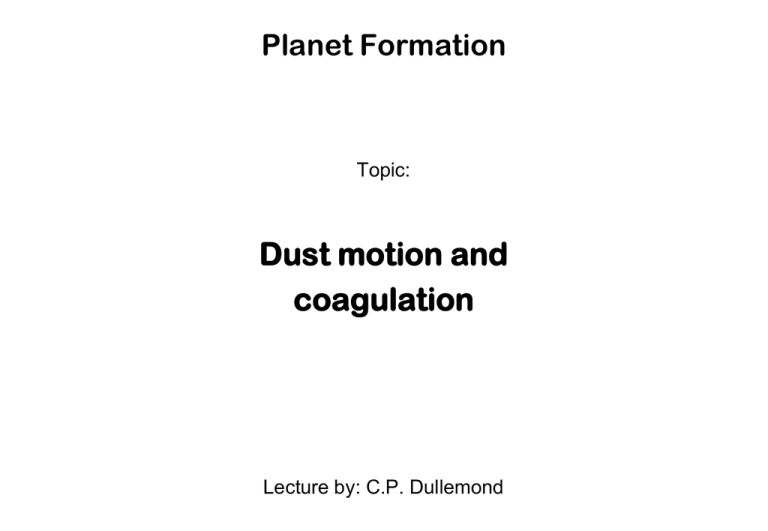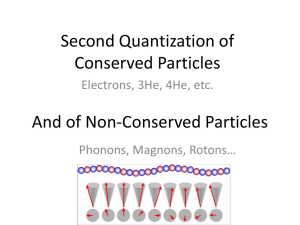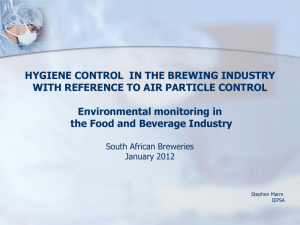Dust coagulation and motion
advertisement

Planet Formation Topic: Dust motion and coagulation Lecture by: C.P. Dullemond Coagulation as the start of planet formation First growth phase Final phase Gravity keeps/pulls bodies together Aggregation (=coagulation) 1m 1mm Coagulation dominates the growth of small particles 1m 1km Unclear if coagulation (=aggregation) is dominant up to >km size planetesimals 1000km Gas is accreted Coagulation: What it is... ...if we look at a single pair of colliding particles: x hit and stick Collision & sticking of „monomers“ leads to a „diamer“ which is a small „aggregate“ t Coagulation: What it is... ...if we look at a single pair of colliding particles: x hit and stick t Collision & sticking of aggregates leads to larger aggregates. Coagulation: What it is... ...if we look at a single pair of colliding particles: x hit and stick t Such aggregate-aggregate collisions leads to „fluffy“ aggregates Coagulation is driven by particle motion Part 1: Stochastic motions: Brownian Motion and Turbulence Relative velocities between particles • Coagulation requires relative velocities between particles, so that they can hit and stick: – stochastic motions due to Brownian motion and turbulent stirring – systematic relative velocities due to particle drift Brownian motion: 8(m1 + m2 )kBT Dv bm = p m1m2 The smallest particles move the fastest, and dominate the collision rate. Turbulent stirring • Turbulence can induce stochastic motions of particles. • To compute this, we must first understand friction between dust and gas... • ...and for this we must understand a few things about the Maxwell-Boltzmann distribution of the gas. So hold on a moment as we discuss friction... Maxwell-Boltzmann distribution When we speak about „average gas particle velocity“ it can have many different meanings, depending on how you do the averaging: Friction between a particle and the gas Take a spherical dust particle with radius a and material density ρs Epstein drag regime = a<<λmfp and |v|<<cs dust particle gas particles Friction between a particle and the gas Take a spherical dust particle with radius a and material density ρs Epstein drag regime = a<<λmfp and |v|<<cs Collision rate of gas particles hitting dust particle from left(+)/right(-): r = gas density Each particle comes in with average relative momentum (compared to the dust particle): Dp± » mmp (± v x - Dv) But leaves with thermalized momentum: i.e. a single kick. Friction between a particle and the gas Epstein drag regime = a<<λmfp and |v|<<cs Dp± » mmp (± v x - Dv) Total drag is: 2 2ù é f = R+Dp+ + R-Dp- = p a r ê( v x - Dv) - ( v x + Dv) ú ë û 2 » -4p a r v x Dv = - p a rv th Dv 2 2 where v th º v 2 8kBT k BT º =4 = 4 vx pm m p 2pm m p Friction between a particle and the gas Epstein drag regime = a<<λmfp and |v|<<cs A more rigorous derivation, taking into account the full velocity distribution and the spherical shape of the particle yields a slight modification of this formula, but it is only a factor 4/3 different: fEpstein 4p 2 =a rv th Dv 3 Note: Δv is the relative velocity between the particle and the gas: Dv º v dust - vgas Friction between a particle and the gas • The Epstein regime is valid for small enough dust particles. • Other regimes include: – Stokes regime: Particle is larger than gas mean free path – Supersonic regime: Particle moves faster than sound speed • For simplicity we will assume Epstein from now on, at least for this chapter. The „stopping time“ The equation of motion of a dust particle in the gas is: dv 4p 2 m = fEpstein = a rv th ( v - vgas ) dt 3 with 4p 3 m= rs a 3 Solution: v(t) = v 0 e With: -t/t stop ( + vgas 1- e rs a t stop º r v th -t/t stop ) The dust particle wants to approach the gas velocity on a timescale t stop back to: Turbulent stirring Small dust grains have small stopping time, so they quickly adapt to the local flow: eddy small dust grain t stop << t eddy Big dust grains have long stopping time, so they barely adapt to the local flow: eddy large dust grain t stop >> t eddy Turbulent stirring: The „Stokes Number“ Compare to largest eddy: t eddy,largest 1 = WK The ratio is called the „Stokes number“ (note: nothing to do with „Stokes regime“) St º t stop t eddy,largest æ WK r s ö = WK t stop = ç ÷a è r v th ø The Stokes number tells whether the particle is coupled to the turbulence (St<<1) or does not feel the turbulence (St>>1) or somewhere in between. It is a proxy of the grain size (large a = large St, small a = small St). Turbulent stirring: Particle mean velocity Due to turbulence, a particle acquires stochastic motions. • For St<<1 (small) particles these motions follow the gas motion. • For St>>1 (big) particles these motions are weak log(Δvdust) Δveddy,large Note: Small particles also couple to smaller eddies, but they are slower than the largest one (see chapter on turbulence) St=1 Large particles decouple from the turbulence, so Δvd goes down with increasing St. log(St) Turbulent stirring: Particle diffusion Diffusion can transport particles, and is therefore important for the dust coagulation problem. For the gas the diffusion coefficient is equal to the gas viscosity coefficient: 2 cs Dgas = n gas = a WK Because of the above described decoupling of the dust dynamics from the gas dynamics, the dust diffusion coefficient is: Ddust = Dgas 1+ St 2 Youdin & Lithwick 2007 To remind you how D is „used“, here is the standard diffusion equation: ¶rdust - Ñ ( Ddust Ñrdust ) = 0 ¶t Turbulent stirring: Collision velocities The stochastic velocities induced by turbulence can lead to collisions between particles. This is the essential driving force of coagulation. Let‘s first look at collisions between equal-size particles: log(Δvcoll) Δveddy,large Small particles of same size will move both with the same eddy, so their relative velocity is small St=1 Large particles decouple from the turbulence, so Δvcoll goes down with increasing St. log(St) Turbulent stirring: Collision velocities Now for collisions of a particle with St1 with tiny dust particles with St2<<1. Now the decoupling of the large particle for St1>>1 actually increases the relative velocities with the tiny dust particles! log(Δvcoll) Δveddy,large Small particles of same size will move both with the same eddy, so their relative velocity is small St1=1 Large particles decouple from the turbulence, they simpy feel gusts of wind from arbitrary directions, bringing along small dust. log(St1) Turbulent stirring: Collision velocities Now for collisions of a particle with St1 with big boulders with St2>>1. Now the coupling of the particle for St1<<1 to the turbulence increases the relative velocities with the boulders for the same reason as described above. log(Δvcoll) Δveddy,large Small particles will populate the „gusts of wind“ the big boulders experience, and thus will lead to large collision velocities St=1 Large particles decouple from the turbulence, so Δvcoll goes down with increasing St. log(St) Turbulent stirring: Collision velocities This diagram shows these results as a function of the grain sizes of both particles involved in the collision. Windmark et al. 2012 Coagulation is driven by particle motion Part 2: Systematic motions: Vertical settling and radial drift Dust settling A dust particle in the disk feels the gravitational force toward the midplane. As it starts falling, the gas drag will increase. A small enough particle will reach an equilibrium „settling velocity“. Vertical motion of particle Vertical equation of motion of a particle (Epstein regime): 1 dz t stop dt Damped harmonic oscillator: z(t) = z0 e iw t ù 1é 1 1 2 ê w= i ± 4WK - 2 ú 2 êë t stop t stop úû No equator crossing (i.e. no real part of ) for: 1 2WK t stop < 2 (where ρs=material density of grains) rgas v th a< 2 r s WK Vertical motion of particle Conclusion: Small grains sediment slowly to midplane. Sedimentation velocity in Epstein regime: vsett rs a 2 = WK z rgasv th Big grains experience damped oscillation about the midplane with angular frequency: (particle has its own inclined orbit!) and damping time: tdamp » t stop Vertical motion of small particle Vertical motion of big particle Turbulence stirs dust back up Equilibrium settling velocity & settling time scale: rs a 2 vsett (z) = WK z rgas v th t sett (z) = z vsett rgasv th = 2 rs aWK Turbulence vertical mixing: Ddust = z t diff (z) = Ddust 2 Dgas 1+ St 2 = a cs H 1+ St 2 2ö 2 æ 1+ St 2 1+ St z = z =ç ÷ 2 a cs H è a WK ø H 2 Settling-mixing equilibrium The settling proceeds down to a height zsett such that the diffusion will start to act against the settling. Thus height zsett is where the settling time scale and the diffusion time scale are equal: rgasv th æ 1+ St 2 ö z 2 =ç ÷ 2 2 rs aWK è a WK ø H With rgas (z) = æ z2 ö exp ç - 2 ÷ 2p H è H ø Sgas We can now (iteratively) solve for z to find zsett . Settling-mixing equilibrium Radial drift of large bodies Assume swinging has damped. Particle at midplane with Keplerian orbital velocity. Gas has (small but significant) radial pressure gradient. Radial momentum equation: 22 2 v v dP dP v GM --rr f f==--rr K 2 * drdr rr rr Estimate of dP/dr : 2 vf cs2 v 2K -2 r - r = -r r r r dP P r c s2 @ -2 = -2 dr r r Solution for tangential gas velocity: vf2 = v2K - 2c s2 c s2 (vK - vf ) @ vK 25 m/s at 1 AU Radial drift of large bodies Body moves Kepler, gas moves slower. Body feels continuous headwind. Friction extracts angular momentum from body: (v K - vf ) r dl =dt t fric t fric = friction time l = vf r One can write dl/dt as: dl dlK d GM* r » = dt dt dt 1 GM* dr = 2 r dt One obtains the radial drift velocity: dr 2c s2 »r 2 dt t fric v K Radial drift of large bodies Gas slower than dust particle: particle feels a head wind. This removes angular momentum from the particle. Inward drift Radial drift of small dust particles Also dust experiences a radial inward drift, though the mechanism is slightly different. Small dust moves with the gas. Has sub-Kepler velocity. Gas feels a radial pressure gradient. Force per gram gas: 1 dP c s2 f gas = @2 r dr r Dust does not feel this force. Since rotation is such that gas is in equilibrium, dust feels an effective force: c s2 f eff = - f gas = -2 r Radial inward motion is therefore: dr c s2 = -2 t fric dt r Radial drift of small dust particles Gas is (a bit) radially supported by pressure gradient. Dust not! Dust moves toward largest pressure. Inward drift. In general (big and small) Brauer et al. 2008 dr dt æ d lg Pgas ö cs2 v r,gas dr 1 º v drift = + ÷ 2 -1 ç dt 1+ St St + St è d lgr ø v K Simple analytical models of coagulation Two main growth modes: Cluster-cluster aggregation (CCA): Particle-cluster aggregation (PCA): 0.1 m 0.1 m Simple model of cluster-cluster growth Let us assume that at all times all aggregates have the same size a(t), but that this size increases with time. We assume that we have a total density of solids of ρdust. The number density of particles then becomes: ndust (t) = rdust m(t) The increase of m(t) with time depends on the rate of collisions: dm(t) 2 = m(t) ndust (t)p (2a(t)) Dv coll (a(t)) dt Here we assume that the particles are always spheres. The cross section of collision is then π(2a)2. Simple model of cluster-cluster growth Let‘s assume Brownian motion as driving velocity: 16kBT Dv coll = Dv bm = p m(t) The growth equation thus becomes proportional to: dm 1 2/3 -1/2 1/6 µm m m µm dt m The powerlaw solution goes as: m(t) µ t 6/5 a(t) µ t 2/5 Mass grows almost linearly with time. Turns out to be too slow... Simple model of cluster-particle growth We assume that a big particle resides in a sea of small-grained dust. Let‘s assume that the big particle has a systematic drift velocity Δv with respect to the gas, while the small particles move along with the gas. The small particles together have a density ρdust. The big particle simply sweeps up the small dust. Then we have: dm(t) 2 = rdust p a (t)Dv dt The proportionalities again: dm(t) = m 2/3 dt The powerlaw solution is: m(t) µ t 3 a(t) µ t How to properly model the coagulation of 1030 particles? Particle distribution function: We „count“ how many particles there are between grain size a and a+da: log(N(a)) log(a) Total mass in particles (total „dust mass“): M= ò amax 0 amax 3 4p m N(a)da = rs ò 0 a N(a)da 3 Particle distribution function: ALTERNATIVE: We „count“ how many particles there are between grain mass m and m+dm: log(N(m)) log(m) Total mass in particles (total „dust mass“): M= ò mmax 0 m N(m)dm Particle distribution function: Relation between these two ways of writing: N(m)dm = N(a)da Exercise: The famous „Mathis, Rumpl, Nordsieck“ (MRN) distribution goes as (for a given range in a) N(a) µ a-7/2 Show that this is equivalent to: N(m) µ m-11/6 And argue that the fact that m2 N(m) µ m1/6 means that the MRN distribution is mass-dominated by the large grains (i.e. most of the mass resides in large grains, even though most of the grains are small). How to model growth Modeling the population of dust (1030 particles!) a N( x,a; t) Aggregation Equation: Distribution in: - Position x = (r,z) - Size a - Time t How to model growth Modeling the population of dust (1030 particles!) 1 2 3 4 5 6 7 8 9 10 11 12 mass Simple model of growth Relative velocities: BM + Settling + Turbulent stirring Collision model: Perfect sticking Dullemond & Dominik 2004 Main problem: high velocities 30 m/s = 100 km/h !! Particle size [meter] Dust coagulation+fragmentation model Σdust [g/cm2] 10-2 10-4 10-6 10-8 10-4 10-2 Grain size [cm] Birnstiel, Dullemond & Ormel 2010 100 Dust coagulation+fragmentation model Σdust [g/cm2] 10-2 10-4 10-6 10-8 10-4 10-2 Grain size [cm] Birnstiel, Dullemond & Ormel 2010 100 Meter-size barrier Growth from ‘dust’ to planetary building blocks Meter-size barrier Rapid radial drift Aggregation Brownian motion 1m Differential settling Fragmentation Sweep-up growth Turbulence 1mm 1m 1km More barriers... Growth from ‘dust’ to planetary building blocks Charge barrier Bouncing barrier Meter-size barrier Rapid radial drift Aggregation Brownian motion 1m Differential settling Fragmentation Sweep-up growth Turbulence 1mm 1m Zsom et al. 2010, Güttler et al. 2010 Okuzumi 2009 1km The “Lucky One” idea Let’s focus on the fragmentation barrier Growth from ‘dust’ to planetary building blocks Meter-size barrier Rapid radial drift Aggregation Brownian motion 1m Differential settling Fragmentation Sweep-up growth Turbulence 1mm 1m 1km The “Lucky One” idea Particle abundance Low sticking efficiency Windmark et al. 2012 How to create these seeds? Perhaps velocity distributions: Garaud et al. 2013; Windmark et al. 2012





